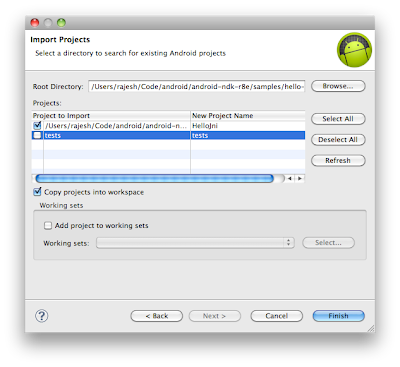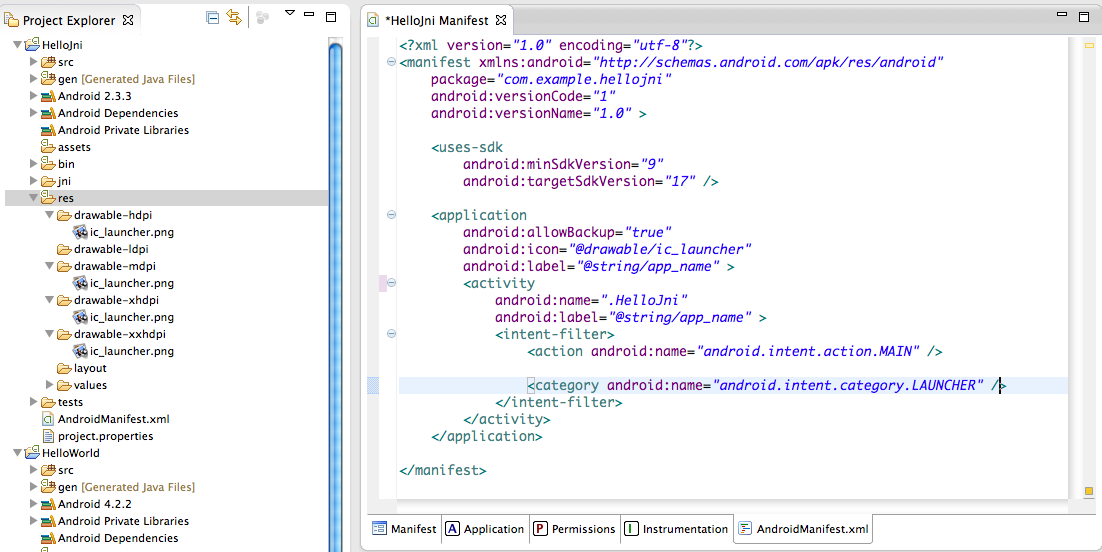

- #Eclipse android ndk install
- #Eclipse android ndk update
- #Eclipse android ndk for android
- #Eclipse android ndk code
- #Eclipse android ndk windows
The remaining code deals with the GUI aspects which are identical to the previous C simple example. Note the static constructor and the interesting JNI code is in the nativeCall method. OutputText.append( Shape.getNshapes() + " shapes remain\n" ) You could leave this to the garbage collector Note: this invokes the virtual destructor OutputText.append( "\nGuess I'll clean up now\n" ) invoke the appropriate virtual method on each object. Notice how the area() and perimeter() functions really OutputText.append( " perimeter = " + shapes.perimeter() + "\n" ) OutputText.append( " area = " + shapes.area() + "\n" ) OutputText.append( " " + shapes.toString() + "\n" ) OutputText.append( "\nHere are some properties of the shapes:\n" ) OutputText.append( " Circle = (" + c.getX() + " " + c.getY() + ")\n" ) C:/Android/android-ndk-r8c/build/core/add-application.mk:128: Android NDK: WARNING: APPPLATFORM android-14 is larger than android:minSdkVersion 4 in. OutputText.append( "\nHere is their current position:\n" ) Now use the same functions in the base class Notice how we can do this using functions specific to OutputText.append( "\nA total of " + Shape.getNshapes() + " shapes were created\n" ) OutputText.append( " Created square " + s + "\n") OutputText.append( " Created circle " + c + "\n") OutputText.append( "Creating some objects:\n" ) The associated resources need to be created, modify res/layout/main.xml as follows: The above simply adds a Run button and scrollable text view as the GUI aspects of the program. Scroller.fullScroll(ScrollView.FOCUS_DOWN) Scroller = (ScrollView)findViewById(R.id.Scroller) tMovementMethod(new ScrollingMovementMethod()) OutputText = (TextView)findViewById(R.id.OutputText) ** Called when the activity is first created.
#Eclipse android ndk windows
The Eclipse version is not required for these examples as just the command line tools are used (shown for Linux as the host, but Windows will be very similar, if not identical in most places).Īdd the SDK tools and NDK tools to your path and create a directory somewhere for your Android projects (adjust PATH as necessary to where you installed the tools): The examples require the Android SDK and Android NDK which can be installed as per instructions in the links.


This chapter contains a few Android specific notes and examples.ġ8.2 Android examples 18.2.1 Examples introduction Used to call from Android Java into C or C++ compiled code.Įverything in the Java chapter applies to generating code for access from Android Java code.
#Eclipse android ndk for android
The Android chapter is fairly short as support for Android is the same as for Java, where the Java Native Interface (JNI) is But you can use ELF binary parsers of the CDT to examine the libraries that are built.This chapter describes SWIG's support of Android. Unfortunately, CDT cannot help you with debuggong. project-specific.ĭone! Your projects will build now including Make -f $/build/platforms/android-8/arch-arm/usr/include Uncheck "Use default build command", and type Properties -> C/C++ Build -> Builder settings tab. Once again, right-click on the project, go to the It will show up as Java only, expecting you to run the build from the Cygwin command prompt. Now it's time to import an existing Android project (C:\APPS\android-ndk-r4\sa Follow the instructions there to add CDT to your Eclipse. NDK_ROOT environment variable to point there.ĭownload Eclipse CDT (C Development Tools) from
#Eclipse android ndk install
Follow the instructions on the SDK page to install JDK, Eclipse, and ADT plugin. Unpack it to a directory without spaces in the folder name.

I set the environment variableĬYGWIN=nodosfilewarning to make Windows integration easier. Make sure that c:\cygwin\bin is added to PATH. I recommend using the default installation directory: Install it in Get Your Eclipse-Integrated NDK On! Luckily, with the new R4 release of the Android Native Development Kit (NDK), the procedure has become much much easier. This was inspired by Robert Green's article, Instructions for debugging your native code with Eclipse. Sequoyah Project automates most of the tasks discussed in this article.
#Eclipse android ndk update
Update (December 2011): Since this article was published, the things have changed for good for Android native developers.


 0 kommentar(er)
0 kommentar(er)
